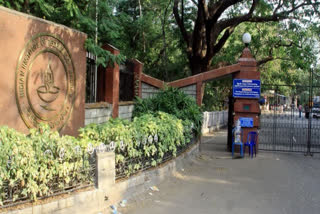Chennai:Indian Institute of Technology Madras and Vellore Institute of Technology (VIT), Chennai, are collaborating with Queen Mary University of London (QMUL), the UK, to develop India-centric Air Sanitization Technologies and guidelines to prevent the spread of Coronavirus and Tuberculosis. This system is aimed at deployment in confined indoor places such as offices and hospitals.
This joint research aims to develop a robust low-cost bio-aerosol protection system to suppress air-transmitted diseases in indoor locations. In collaboration with Magneto Cleantech, a pioneering industry start-up based in Delhi, the testing and implementation will be done with real-time applications in various Indian environments.
COVID-19 pandemic has claimed more than four lakh lives in India alone. TB killed over 4.45 lakh people in India during 2019 and is among the top 10 causes of death worldwide.
The target geographies for this project are India and its adjacent countries. The major factor working with this area is the high population and heavy urban pollution. It is expected that this project, when successfully implemented, will benefit nearly 10 crore people in the Indian sub-continent.
The project will be aimed at developing an experimental proof-of-concept of a revolutionary air filtration system using ‘Ultraviolet-C’ radiation. It has a strong potential to increase the effectiveness of eliminating viruses and other airborne pathogens and reduce maintenance costs as compared to the available filters, which is important for developing countries such as India.
Elaborating on the current status of the project and expected field deployment, Project Coordinator Prof. Abdus Samad, Department of Ocean Engineering, IIT Madras, said, “IIT Madras always tries for collaborative research to solve societal problems. When the Covid lockdown started in March 2020, we all got scared. As a researcher, we started thinking how to reduce the pain and distress caused by the airborne viruses. At the same time, the Royal Academy of Engineering of the UK announced research funding for international collaborative works linking to industry. We immediately took action and started research on disinfecting air for indoor conditions.”
Further, Prof. Abdus Samad said, “Various UVC solutions are present in the market but they lack the technical design rigor needed to ensure appropriate airborne disinfection and inactivation. This has led to consumer confusion and mistrust. The projects’ goal is to develop a solution that is extensively verified and tested from both theoretical and practical perspectives, and finally, the safety made visible in a consumer-friendly manner ensuring live performance of the system.”
Also Read:Not zero, net zero: Universities, institutes work towards reducing carbon footprint on campuses
In keeping with the Government of India’s goal of ‘Atmanirbhar Bharat’ and ‘Start-up India’ program, the joint consortium will develop products that would be commercialized through Magneto along with the academic institutions. This will pave the way for many new job openings for young budding engineers. This will be an important development for the benefit of society and the entire world in the fight against these diseases.
Highlighting the technical aspects of the project, Prof. Nithya Venkatesan, Professor, School of Electrical Engineering, Vellore Institute of Technology (VIT), Chennai, said, “The design of this prototype will be based on multidisciplinary optimization, fluid dynamic analysis, and novel innovations in Ultraviolet-C (UVC) arrangements and sensors and controls developed by leading UK and Indian researchers. The team will also explore mechanisms for monitoring the performance of such systems in real-time environments using new-age bio-sensing and simulations through an IoT device.”
Further Prof. Nithya Venkatesan said, “One very important aspect is that we will seek to establish guidelines for how to use this air cleaning device in concert with other policies of cleaning, ventilation, and social distancing. We will account for the features found in high-density population centres in India and similar developing countries. This will be achieved through advanced fluid dynamics modelling, risk analysis, and co-operation with national and local stakeholders.”
